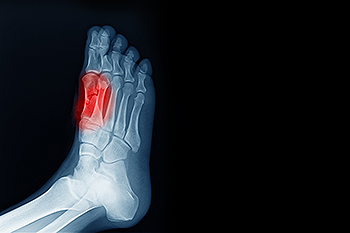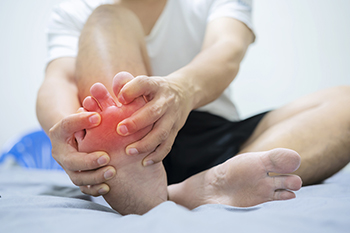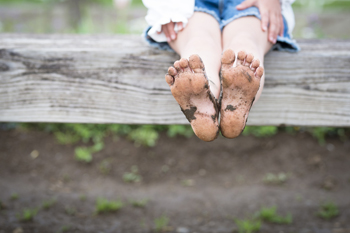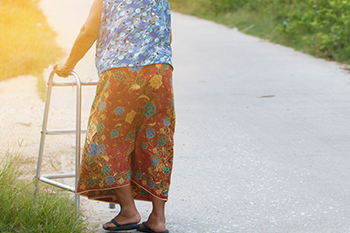Blog
Blisters and Basketball

Blisters can develop on the feet for any number of reasons and there are several different kinds of blisters that may form. Blisters may form in response to repeated pressure or friction on the feet while an individual is playing basketball. If a basketball player is wearing inadequate footwear, then this may also cause blisters. Importantly, blisters are composed of a layer of skin that produces a watery kind of pus. If you have blisters from basketball, it is important to take care of your feet so that the blisters can heal. You might also try to prevent future blisters from developing by wearing basketball shoes that provide enough room in the shoes. You might even be sure to wear socks that properly cover the feet. Contact a podiatrist today for information about blisters from basketball.
Blisters may appear as a single bubble or in a cluster. They can cause a lot of pain and may be filled with pus, blood, or watery serum. If your feet are hurting, contact Genine Befumo, DPM of University Foot and Ankle Center, L.L.C. Our doctor can provide the care you need to keep you pain-free and on your feet.
Foot Blisters
Foot blisters are often the result of friction. This happens due to the constant rubbing from shoes, which can lead to pain.
What Are Foot Blisters?
A foot blister is a small fluid-filled pocket that forms on the upper-most layer of the skin. Blisters are filled with clear fluid and can lead to blood drainage or pus if the area becomes infected.
Symptoms
(Blister symptoms may vary depending on what is causing them)
- Bubble of skin filled with fluid
- Redness
- Moderate to severe pain
- Itching
Prevention & Treatment
In order to prevent blisters, you should be sure to wear comfortable shoes with socks that cushion your feet and absorb sweat. Breaking a blister open may increase your chances of developing an infection. However, if your blister breaks, you should wash the area with soap and water immediately and then apply a bandage to the affected area. If your blisters cause severe pain it is important that you call your podiatrist right away.
If you have any questions, please feel free to contact our office located in Monroe Township, NJ . We offer the newest diagnostic and treatment technologies for all your foot care needs.
Subspecialties in Podiatry

Podiatrists are foot specialists in the medical field that can help treat a wide variety of foot conditions in their patients. Podiatrists can diagnose and treat foot conditions such as plantar fasciitis, athlete’s foot, Achilles tendonitis, heel spurs, and so much more. Importantly, there are many subspecialties in the field of podiatry that a podiatrist might be acquainted with. One popular subspecialty in podiatry is known as sports medicine. These podiatrists deal specifically with athletes and are very familiar with particular foot afflictions that affect this group of people. These podiatrists know a great deal about the biomechanics of the foot and rehabilitation techniques. Contact a podiatrist today with additional questions about what they do and what they specialize in.
If you are experiencing pain in the feet or ankles, don’t join the stubborn majority refusing treatment. Feel free to contact Genine Befumo, DPM from University Foot and Ankle Center, L.L.C. Our doctor can provide the care you need to keep you pain-free and on your feet.
What Is a Podiatrist?
Someone would seek the care of a podiatrist if they have suffered a foot injury or have common foot ailments such as heal spurs, bunions, arch problems, deformities, ingrown toenails, corns, foot and ankle problems, etc.
Podiatric Treatment
A podiatrist will treat the problematic areas of the feet, ankle or lower leg by prescribing the following:
- Physical therapy
- Drugs
- Orthotic inserts or soles
- Surgery on lower extremity fractures
A common podiatric procedure a podiatrist will use is a scanner or force plate which will allow the podiatrist to know the designs of orthotics. Patients are then told to follow a series of tasks to complete the treatment. The computer will scan the foot a see which areas show weight distribution and pressure points. The podiatrist will read the analysis and then determine which treatment plans are available.
If you have any questions please feel free to contact our office located in Monroe Township, NJ . We offer the newest diagnostic and treatment technologies for all your foot and ankle needs.
Treating Sesamoiditis

Sesamoiditis is a particular kind of foot affliction that primarily affects the sesamoid bones near the big toe. The sesamoid bones are two small bones located beneath the big toe joint, and when they become inflamed, a condition known as sesamoiditis can develop. There are several ways in which one with sesamoiditis might go about treating this condition. For example, someone with sesamoiditis might try making adjustments to the kind of footwear that they are wearing. Taking this step might help alleviate pain. Opting to wear shoes that have more cushioning in the affected area might be beneficial. Additionally, wearing custom orthotics in the shoes can help further reduce pain and mitigate the condition. Besides making adjustments to the shoes that one wears, one might also consider adjusting their daily physical activities, excluding those that put extra strain on the affected sesamoid bones. Contact a podiatrist today for more information.
Sesamoiditis is an unpleasant foot condition characterized by pain in the balls of the feet. If you think you’re struggling with sesamoiditis, contact Genine Befumo, DPM of University Foot and Ankle Center, L.L.C. Our doctor will treat your condition thoroughly and effectively.
Sesamoiditis
Sesamoiditis is a condition of the foot that affects the ball of the foot. It is more common in younger people than it is in older people. It can also occur with people who have begun a new exercise program, since their bodies are adjusting to the new physical regimen. Pain may also be caused by the inflammation of tendons surrounding the bones. It is important to seek treatment in its early stages because if you ignore the pain, this condition can lead to more serious problems such as severe irritation and bone fractures.
Causes of Sesamoiditis
- Sudden increase in activity
- Increase in physically strenuous movement without a proper warm up or build up
- Foot structure: those who have smaller, bonier feet or those with a high arch may be more susceptible
Treatment for sesamoiditis is non-invasive and simple. Doctors may recommend a strict rest period where the patient forgoes most physical activity. This will help give the patient time to heal their feet through limited activity. For serious cases, it is best to speak with your doctor to determine a treatment option that will help your specific needs.
If you have any questions please feel free to contact our office located in Monroe Township, NJ . We offer the newest diagnostic and treatment technologies for all your foot and ankle needs.
Foods That Cause or Worsen Gout

Gout is a type of inflammatory arthritis that results in swelling and severe pain in joints. It often shows itself in the big toe joint first. This condition comes on from having high uric acid levels in the blood and the formation of crystals in the joints. Uric acid is produced when purines, a naturally occurring substance in the body, are broken down and excess acid is not eliminated. Purines can also be found in certain foods, particularly red meats, seafood, high-sugar beverages, alcohol, and beer. It is important to limit the consumption of these foods if one is prone to gout. If you have pain in the joint of your big toe and you think it might be gout or have no idea what it could be from, see a podiatrist who can make an accurate diagnosis and provide treatment.
Gout is a painful condition that can be treated. If you are seeking treatment, contact Genine Befumo, DPM from University Foot and Ankle Center, L.L.C. Our doctor will treat your foot and ankle needs.
What Is Gout?
Gout is a form of arthritis that is characterized by sudden, severe attacks of pain, redness, and tenderness in the joints. The condition usually affects the joint at the base of the big toe. A gout attack can occur at any random time, such as the middle of the night while you are asleep.
Symptoms
- Intense Joint Pain - Usually around the large joint of your big toe, and it most severe within the first four to twelve hours
- Lingering Discomfort - Joint discomfort may last from a few days to a few weeks
- Inflammation and Redness -Affected joints may become swollen, tender, warm and red
- Limited Range of Motion - May experience a decrease in joint mobility
Risk Factors
- Genetics - If family members have gout, you’re more likely to have it
- Medications - Diuretic medications can raise uric acid levels
- Gender/Age - Gout is more common in men until the age of 60. It is believed that estrogen protects women until that point
- Diet - Eating red meat and shellfish increases your risk
- Alcohol - Having more than two alcoholic drinks per day increases your risk
- Obesity - Obese people are at a higher risk for gout
Prior to visiting your podiatrist to receive treatment for gout, there are a few things you should do beforehand. If you have gout you should write down your symptoms--including when they started and how often you experience them, important medical information you may have, and any questions you may have. Writing down these three things will help your podiatrist in assessing your specific situation so that he or she may provide the best route of treatment for you.
If you have any questions, please feel free to contact our office located in Monroe Township, NJ . We offer the newest diagnostic and treatment technologies for all your foot care needs.
A Cut on the Foot Is Not So Simple for Diabetic Patients

Looking after the feet is crucial for diabetic patients because a minor cut on the bottom of the foot can pose very serious health threats. This can be prevented when the feet are checked every day which can be accomplished by using a mirror. If a family member or caregiver is available, they may be able to help with this task. Additionally, washing and drying the feet is important in maintaining proper foot hygiene, and doing this may stop an infection from entering the body. Diabetes can increase the chances of having poor circulation, foot ulcers, and infections, and there are methods that can be implemented which may help to control this condition. The overall body can be helped by checking blood glucose levels often, in addition to quitting tobacco products for diabetic patients who smoke. Trimming the toenails weekly is important in practicing foot care, and this is often done by a podiatrist. If you have diabetes, it is strongly advised that you visit a podiatrist often, who can help you to manage this condition.
Diabetic foot care is important in preventing foot ailments such as ulcers. If you are suffering from diabetes or have any other concerns about your feet, contact Genine Befumo, DPM from University Foot and Ankle Center, L.L.C. Our doctor can provide the care you need to keep you pain-free and on your feet.
Diabetic Foot Care
Diabetes affects millions of people every year. The condition can damage blood vessels in many parts of the body, especially the feet. Because of this, taking care of your feet is essential if you have diabetes, and having a podiatrist help monitor your foot health is highly recommended.
The Importance of Caring for Your Feet
- Routinely inspect your feet for bruises or sores.
- Wear socks that fit your feet comfortably.
- Wear comfortable shoes that provide adequate support.
Patients with diabetes should have their doctor monitor their blood levels, as blood sugar levels play such a huge role in diabetic care. Monitoring these levels on a regular basis is highly advised.
It is always best to inform your healthcare professional of any concerns you may have regarding your feet, especially for diabetic patients. Early treatment and routine foot examinations are keys to maintaining proper health, especially because severe complications can arise if proper treatment is not applied.
If you have any questions please feel free to contact our office located in Monroe Township, NJ . We offer the newest diagnostic and treatment technologies for all your foot and ankle needs.
Kohler Disease and Its Impact on Children

Kohler disease is a rare bone disorder that causes a child’s foot to hurt and swell. This disease usually impacts children between the ages of 3 to 7. Boys are much more likely to be afflicted with Kohler disease than girls. The flow of blood to the navicular bone in the foot is interrupted and there is a progressive degeneration of the bone. Some experts believe it may be related to an injury near the navicular bone and delayed bone formation leading to structural weakness. It can be caused by genetic factors, or it may develop from stress-related compression during a child’s growth period. A child will often limp or walk on the side of their foot because it might hurt them to put weight on it. There may be tenderness along the length of the arch and the affected area may redden. Those with this disorder most often outgrow it and the affected bone regains size, density, and structure. It often resolves itself within three months to two years. Since other disorders can have symptoms similar to those of Kohler disease, treatment can be helpful. If your child is complaining of foot pain or you notice a gait change, contact a podiatrist who can diagnose the problem and offer remedies.
Some foot conditions may require additional professional care. If you have any concerns, contact Genine Befumo, DPM of University Foot and Ankle Center, L.L.C. Our doctor can provide the care you need to keep you pain-free and on your feet.
Rare Foot Conditions
The majority of foot conditions are common and can be treated by a podiatrist. Standard diagnostic procedures are generally used to identify specific conditions and treatment can be rendered. A podiatrist also treats rare foot conditions which can be difficult to diagnose and may need extra attention and care.
There are many rare foot conditions that can affect children. Some of these can include:
- Freiberg’s disease
- Kohler’s disease
- Maffucci syndrome
Freiberg’s disease - This can be seen as a deterioration and flattening of a metatarsal bone that exists in the ball of the foot. It typically affects pre-teen and teenage girls, but can affect anyone at any age. Symptoms that can accompany this can be swelling, stiffness, and the patient may limp.
Kohler’s disease - This often targets the bone in the arch of the foot and affects younger boys. It can lead to an interruption of the blood supply which ultimately can lead to bone deterioration. The patient may limp or experience tenderness, swelling, and redness.
Maffucci syndrome - This affects the long bones in a child’s foot leading to the development of abnormal bone lesions. They are benign growths and typically develop in early childhood and the bones may be susceptible to breaking.
A podiatrist can properly diagnose and treat all types of rare foot conditions. If your child is affected by any of these symptoms or conditions, please don’t hesitate to call our office so the correct treatment method can begin.
If you have any questions please feel free to contact our office located in Monroe Township, NJ . We offer the newest diagnostic tools and technology to treat your foot and ankle needs.
Keeping Your Feet Dry in Work Boots

When you perspire, it is nature’s way of helping to regulate your body temperature. This is done through the many sweat glands throughout the body, including the toes and feet. When working on your feet, especially if you need to wear work boots, the chances of moisture collecting inside the shoes are multiplied. Keeping the feet dry can pose a challenge, but experts suggest a few ways to do just that. First, choose work boots that are breathable. Obviously, work boots must not only support your feet, but protect them. Some types of work boots are made with mesh linings that can help to keep excess moisture from building up. Also, it is suggested that wearing socks that wick moisture can help to keep your feet dry. Using foot powder and keeping your feet clean are other methods that can work to limit the buildup of bacteria, which can cause foot odor. For more information on the type of work boot that is best for your feet, please see a podiatrist.
While working on the feet, it is important to take the proper care of them. For more information about working on your feet, contact Genine Befumo, DPM from University Foot and Ankle Center, L.L.C. Our doctor will treat your foot and ankle needs.
Working on Your Feet
Standing on your feet for long periods of time can cause stress and pain in your feet. Your whole body may experience change in terms of posture, back pain, bunions, callouses and or plantar warts. There are ways to avoid these conditions with proper foot care, smart choices and correct posture.
Positive Changes
Negative heeled shoe – Choosing this shoe type places the heel slightly lower than the ball of the foot. These are great for overall foot health. Find shoes that fit you correctly.
Go barefoot – Our feet were not designed to be enclosed for all hours of the day. Try to periodically expose your feet to air.
Eliminate Pain
Foot Exercises – Performing simple exercises, incorporating yoga and doing stretches are beneficial. This will allow increased blood flow to the area and muscles of the foot.
Achilles tendon – Stretching the foot out flat on the floor will relax the calf muscles and tendon. These exercises can be performed almost anywhere. Make sure you add these exercises to your daily regimen.
With a little bit of this information and knowing more about foot health, you will notice changes. Foot stretches and proper footwear will help with pain and prevent further issues.
If you have any questions please feel free to contact our office located in Monroe Township, NJ . We offer the newest diagnostic and treatment technologies for all your foot and ankle needs.
Can Falls Be Prevented?

Falling among the elderly can invoke a horrible fear to the extent that one may decide to limit their daily activities. This can negatively affect one’s quality of life and leave them socially isolated. Upon falling, many endure serious physical injuries that include the feet, making it difficult to walk. There are measures that can be implemented that may help to protect one from falling. These can include removing frayed rugs from the living environment, improving lighting in the household, and wearing shoes that fit correctly. Additionally, it is beneficial to install grab bars in the shower and toilet area, as well as use bath mats that can help to avoid slipping. Engaging in a gentle exercise program can help to strengthen the overall body and this is essential in falls prevention. If you have questions about additional methods that can prevent falling and the potential harm falling can have on the feet, please contact a podiatrist.
Preventing falls among the elderly is very important. If you are older and have fallen or fear that you are prone to falling, consult with Genine Befumo, DPM from University Foot and Ankle Center, L.L.C. Our doctor will assess your condition and provide you with quality advice and care.
Every 11 seconds, an elderly American is being treated in an emergency room for a fall related injury. Falls are the leading cause of head and hip injuries for those 65 and older. Due to decreases in strength, balance, senses, and lack of awareness, elderly persons are very susceptible to falling. Thankfully, there are a number of things older persons can do to prevent falls.
How to Prevent Falls
Some effective methods that older persons can do to prevent falls include:
- Enrolling in strength and balance exercise program to increase balance and strength
- Periodically having your sight and hearing checked
- Discuss any medications you have with a doctor to see if it increases the risk of falling
- Clearing the house of falling hazards and installing devices like grab bars and railings
- Utilizing a walker or cane
- Wearing shoes that provide good support and cushioning
- Talking to family members about falling and increasing awareness
Falling can be a traumatic and embarrassing experience for elderly persons; this can make them less willing to leave the house, and less willing to talk to someone about their fears of falling. Doing such things, however, will increase the likelihood of tripping or losing one’s balance. Knowing the causes of falling and how to prevent them is the best way to mitigate the risk of serious injury.
If you have any questions, please feel free to contact our office located in Monroe Township, NJ . We offer the newest diagnostic and treatment technologies for all your foot care needs.
Blog Archives
- April 2024
- March 2024
- February 2024
- January 2024
- December 2023
- November 2023
- October 2023
- September 2023
- August 2023
- July 2023
- June 2023
- May 2023
- April 2023
- March 2023
- February 2023
- January 2023
- December 2022
- November 2022
- October 2022
- September 2022
- August 2022
- July 2022
- June 2022
- May 2022
- April 2022
- March 2022
- February 2022
- January 2022
- December 2021
- November 2021
- October 2021
- September 2021
- August 2021
- July 2021
- June 2021
- May 2021
- April 2021
- March 2021
- February 2021
- January 2021
- December 2020
- November 2020
- October 2020
- September 2020
- August 2020
- July 2020
- June 2020
- May 2020
- April 2020
- March 2020
- February 2020
- January 2020
- December 2019
- November 2019
- October 2019
- September 2019
- August 2019
- July 2019
- June 2019
- May 2019
- April 2019
- March 2019
- February 2019
- January 2019
- December 2018
- November 2018
- October 2018
- September 2018
- August 2018
- July 2018
- June 2018
- May 2018
- April 2018
- March 2018
- February 2018
- January 2018
- December 2017
- November 2017
- October 2017
- September 2017
- August 2017
- July 2017
- June 2017
- May 2017
- April 2017
- March 2017
- February 2017
- January 2017
- December 2016
- November 2016
- October 2016
- September 2016
- August 2016
- July 2016
- June 2016
- May 2016
- April 2016
- March 2016
- February 2016
- January 2016
- December 2015
- November 2015
- October 2015
- September 2015
- August 2015
- July 2015
- June 2015
- May 2015
- April 2015
- March 2015
- February 2015
- January 2015
- December 2014
- November 2014
- October 2014
- September 2014
- August 2014
- July 2014






